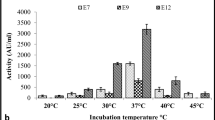Abstract
As increasing demand for eliminating the use of chemical additives in foodstuff, bacteriocins might have significant potential in food preservation. Of 11 strains of Lactobacillus acidophilus isolated from camel milk 3 strains showed inhibitory activity against foodborne pathogens. L. acidophilus AA105 identified by 16S rRNA demonstrated antimicrobial activity of a wide spectrum. The bacteriolytic bacteriocin produced by L. acidophilus AA105 lost no activity after 30 min at 121°C and was sensitive to proteolytic enzymes. This antimicrobial compound produced at logarithm phase of cultivation and extracted with n-butanol was stored at 37°C for at least 70 days without loss of its activity. Native bacteriocin was retained by 5 kDa membrane with full activity. The sequencing of 12 amino acids of the N-terminus was determined as GNPKVAHCASQI. The genes encoding the antimicrobial compound were located on the chromosome but not in plasmid. L. acidophilus AA105 was investigated for susceptibility to available commercially antibiotics. These characteristics classify antimicrobial compound produced by L. acidophilus AA105 as a novel bacteriocin and give this compound an application potential as food biopreservative or antimicrobials.
Similar content being viewed by others
References
Gilliland, S.E. and Speck, M.L., Appl. Environ. Microbiol., 1977, vol. 66, no. 6, pp. 1289–1292.
Morin, A., Saheb, S.A., Bisaillon, J.G., Beaudet, R., and Sylvestre, M., Curr. Microbiol., 1980, vol. 4, no. 5, pp. 283–286.
Tagg, J.R., Dajani, A.S., and Wannamaker, L.W., Bacteriol. Rev., 1976, vol. 40, no. 3, pp. 722–756.
Chen, H. and Hoover, D.G., Comprehensive Rev. Food Sci. Food Safety, 2003, vol. 2, no. 3, pp. 82–100.
Ogunbanwo, S.T., Sanni, A.I., and Onilude, A.A., Afr. J. Biotechnol., 2003, vol. 2, no. 8, pp. 219–227.
Abo-Amer, A.E., Rev. Latinoam. Microbiol., 2006, vol. 48, no. 1, pp. 24–30.
Abo-Amer, A.E., Ann. Microbiol., 2011, vol. 61, no. 3, pp. 445–452.
Abo-Amer, A.E., and Shobrak, M.E., Afr. J. Microbiol. Res., 2012, vol. 6, no. 36, pp. 6589–6599.
Fooks, L.J. and Gibson, G.R., FEMS Microbiol. Ecol., 2002, vol. 39, no. 1, pp. 67–75.
Zamfir, M., Callewaert, R., Cornea, P.C., Savu, L., Vatafu, I., and De Vuyst, L., J. Appl. Microbiol., 1999, vol. 87, no. 6, pp. 923–931.
Bhattachary, S. and Das, A., Am. J. Food Technol., 2010, vol. 5, no. 2, pp. 111–120.
Naidu, A.S., Bidlack, W.R., and Clemens, R.A., Crit. Rev. Food Sci. Nutrition, 1999, vol. 39, no. 1, pp. 13–126.
Khedid, K., Faid, M., Mokhtari, A., Soulaymani, A., and Zinedine, A., Microbiol. Res., 2009, vol. 164, no. 1, pp. 81–91.
Benkerroum, N., Mekkaoui, M., Bennani, N., and Hidane, K., Int. J. Dairy Technol., 2009, vol. 57, no. 1, pp. 39–43.
Krieg, N., Bergey’s Manual of Systematic Bacteriology, Baltimore: Williams and Wilkins, 1984, vols. 1, 2.
Tag, J.R. and McGiven, A.R., Appl. Microbiol., 1971, vol. 21, no. 5, p. 943.
Yu, J., Sun, Z., Liu, W., et al., J. Gen. Appl. Microbiol., 2009, vol. 55, no. 3, pp. 181–190.
Kanatani, K., Oshimura, M., and Sano, K., Appl. Environ. Microbiol., 1995, vol. 61, no. 3, pp. 1061–1067.
O’Sullivan, D.J. and Klaenhammer, T.R., Appl. Environ. Microbiol., 1993, vol. 59, no. 8, pp. 2730–2733.
Charteris, W.P., Kelly, P.M., Morelli, et al., J. Food Prot., 1998, vol. 61, no. 12, pp. 1636–1643.
Aymerich, T., Martin, B., Garriga, M. Vidal-Carou, M.C., Bover-Cid, S., and Hugas, M., J. Appl. Microbiol., 2006, vol. 100, no. 1, pp. 40–49.
Tahara, T. and Kanatani, K., Biosci. Biotechnol. Biochem., 1997, vol. 61, no. 5, pp. 884–886.
Chumchalova, J., Stiles, J., Josephsen, J., and Plockova, M., J. Appl. Microbiol., 2004, vol. 96, no. 5, pp.1082–1089.
Toba, T., Yoshioka, E., and Itoh, T., Lett. Appl. Microbiol., 1991, vol. 12, no. 4, pp. 106–108.
Muriana, P.M., and Klaenhammer, T.R., Appl. Environ. Microbiol., 1991, vol. 57, no. 1, pp. 114–121.
Barefoot, S.F. and Klaenhammer, T.R., Antimicrob. Agents Chemother., 1984, vol. 26, no. 3, pp. 328–334.
Tahar, T., Kanatania, K., Yoshida, K. Miura, H., Sakamoto, M., and Oshimura, M., Biosci. Biotech. Biochem., 1992, vol. 56, no. 8, pp. 1212–1215.
ten Brink, B., Minekus, M., van der Vossen, J.M.B.M., Leer, R. J., and Huis In’t Veld, J.H.J., J. Appl. Bacteriol., 1994, vol. 77, no. 2, pp. 140–148.
Deraz, S.F., Karlsson, E.N., Hedstrom, M. Andersson, M.M., and Mattiasson, B., J. Biotech., 2005, vol. 117, no. 4, pp. 343–354.
Jimenez-Diaz, R., Rios-Sanchez, R.M., and Piard, J.C., Appl. Environ. Microbiol., 1993, vol. 59, no. 5, pp. 1416–1424.
Sivakumar, N, Rajamani, and Saif, A., Braz. Arch. Biol. Technol., 2010, vol. 53, no. 5, pp. 1177–1184.
Rattanachaikunsopon, P. and Phumkhachorn, P., J. Food Prot., 2006, vol. 69, no. 8, pp.1937–1943.
Marroki, A., Zuniga, M, Kihal, M., and Pérez-Martínez, G., Braz. J. Microbiol., 2011, vol. 42, no, 1, pp.158–171.
Ammor, M.S., Flores, A.B., and Mayo, B., Food Microbiol., 2007, vol. 24, no. 6, pp. 559–570.
Piard, J.C. and Desmazeaud, M., Lait, 1992, vol. 72, no. 2, pp. 113–142.
Author information
Authors and Affiliations
Corresponding author
Additional information
The article is published in the original.
Rights and permissions
About this article
Cite this article
Abo-Amer, A.E. Inhibition of foodborne pathogens by a bacteriocin-like substance produced by a novel strain of Lactobacillus Acidophilus isolated from camel milk. Appl Biochem Microbiol 49, 270–279 (2013). https://doi.org/10.1134/S0003683813030174
Received:
Published:
Issue Date:
DOI: https://doi.org/10.1134/S0003683813030174




